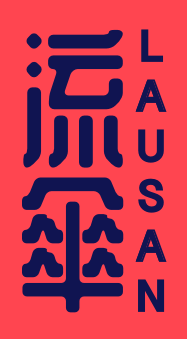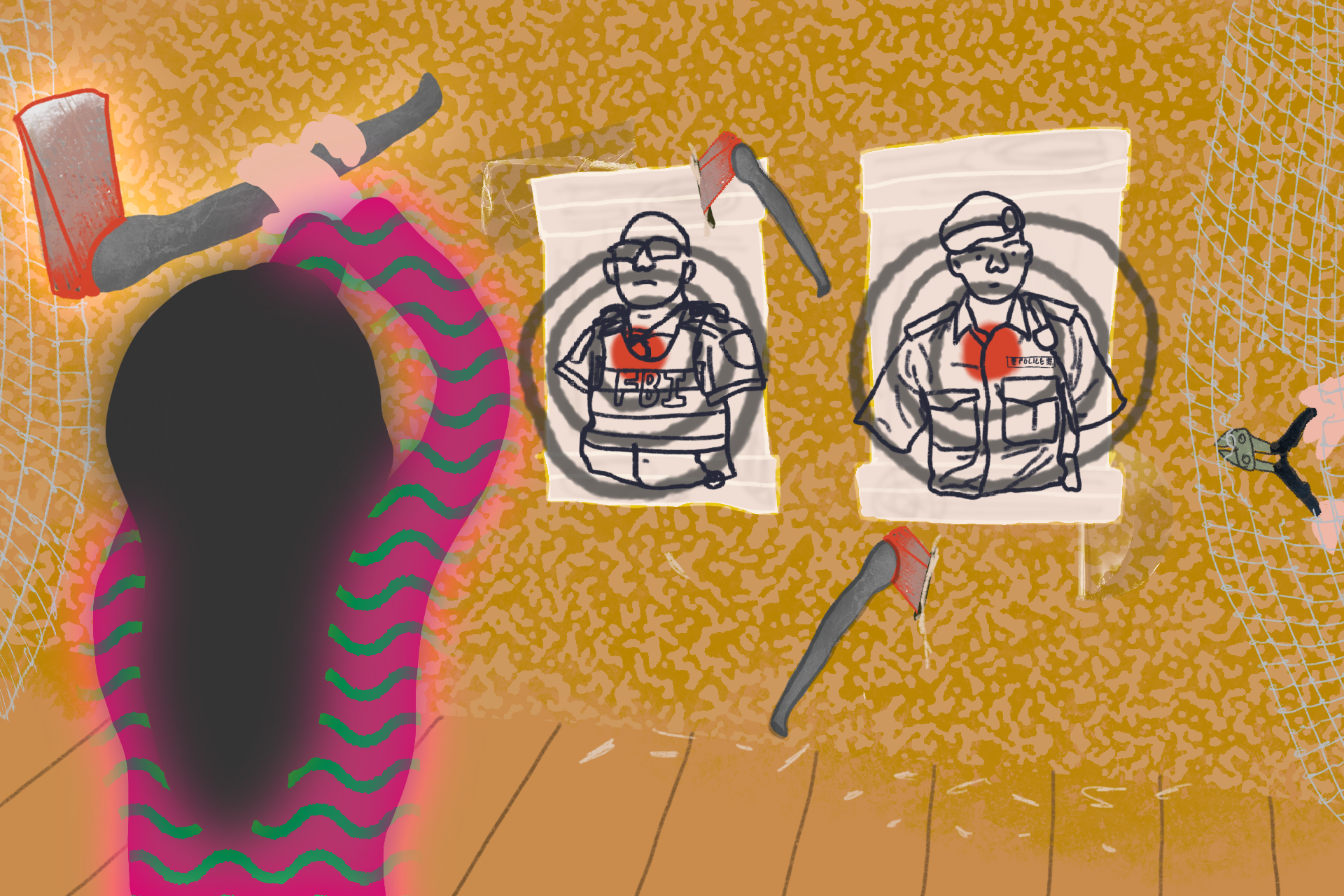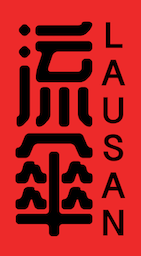In a year of crises, my summer was particularly heavy. From Kansas City, my birthplace where I organize today, to Hong Kong, my familial hometown, it felt as if both poles of my world were burning. My usual Instagram and WhatsApp feed was replaced with variations of the same cellphone video scenes: chemical agents and rubber bullets descending on crowds of young protestors each day. In the span of a week in May, my family went from mailing masks and respirators for relatives overseas to strapping them on ourselves during tear gas-filled protests.
Blooming from places thousands of miles apart in the American Midwest and Hong Kong, a year of unprecedented uprisings has laid bare a global crisis facing state violence and policing. Yet for those of us who live in the margins, this is nothing new. It is not simply a shared spectacle of overzealous policing, but a moment of clarity revealing the violent underpinnings that necessitate policing in the first place.
We understand that crisis need not be inherently good nor bad; when the existing state of order becomes unsustainable, the outcome can only be mapped out through struggle.1 In this moment of historic crisis and resistance where workers are rising up against state violence, the façade of neoliberal, post-racial harmony is fracturing. Something is erupting. Tracing the fault lines exposed under Hong Kong and the United States takes us to their shared and unstable material foundation: racial capitalism. And when we recognize this, we begin to see glimpses of the path forward: the urgent need for a global abolitionist movement.Cut from the same cloth
The Hong Kong Police Force (HKPF) originated from the early decades of British colonization. In the newly-annexed settlement stolen during the First Opium War (1839), European merchants needed insurance to guard their businesses and warehouses against “hostile” Chinese laborers they saw as a threat. Exploiting how ethnic differences divided workers, officials soon imported South Asian officers across the empire to meet this need, forming police forces that subjugated locals and protected white private property.
Where differences between ethnic groups including Cantonese and seoi soeng jan (水上人) previously existed, colonization reified them into a hierarchy of unequal racial groups. In turn, policing acted as the muscle to impose a racialized legal system. Under this new arrangement, Hong Kong police enforced racial segregation and deployed militarized repression to crush racial uprisings and labor strikes.2 In service of property, they arrested thousands each year under a “Light and Pass Ordinance”—with each member of the Chinese race seen as a potential criminal, Chinese Hongkongers were exclusively mandated to carry lamps at night.3
A century prior, a similar policy to ensure colonial profiteering through racialized law enforcement was enacted in the Northern US: New York City’s “Lantern Laws” required Black and Native pedestrians to carry candles after sunset, whose impact on contemporary surveillance have been traced by scholar Simone Brown.4 Protecting the profit-extracting racial order in colonial America, private law enforcement watches formed to enact similar legal codes in different cities. They eventually became police departments in places like Boston to protect the property and business of merchants, much like in Hong Kong.
In the South, their counterparts were slave patrols, organized to enrich European settlers and their descendants by protecting chattel slavery. Through the art of obfuscation, successive generations of policy have adapted to the times while maintaining a material foundation of profit extraction through anti-Black racism. Slave patrols evolved into modern-day police departments through enforcing vagrancy laws5 that pushed freed people back into servitude, Jim Crow segregation that assigned them inferior legal standing, and “tough on crime” criminalization that forced millions into prison cells since the 1960s.6 Coercive penal labor was central to the development of our modern, industrialized, and profiteering racial state.7
Taken together, the modern ethos of American policing emerges from a confluence of these Northern and Southern traditions: From Lantern Laws under colonial mercantilism to plantation patrols under chattel slave codes, the police has enforced capital accumulation along racial lines. Sociologists Michael Omi and Howard Winant describe the American state’s crucial role in making race “real”8 through legalizing repression and hierarchy;9 law enforcement literally “policed” the new, commodified categories that humans were slotted into—“white,” “Negro,” or “Indian.” Abolitionist organizers such as Mariame Kaba have studied how this violent relationship has continued through the centuries.
The striking parallels between the development of policing in Hong Kong and the United States are no coincidence. Across continents, they share a common lineage as state formations that not only introduced and developed, but enforced the boundaries of modern racial capitalism: what Cedric Robinson described as a system of capital accumulation through violent, racial difference. From serving merchant private property, to putting down labor strikes, to crushing anti-colonial revolts,10 police in both locales fulfilled the same function: maintaining racial hierarchy to enforce trade and profit extraction at all costs.
Protecting whose peace today?
Cut from the same cloth of colonial exploitation, police forces in the US and Hong Kong still fundamentally exist to suppress any challenge to the global racial capitalist order. As millions in the US protested this year against local police departments siphoning community wealth from social needs, police have again laid bare their role in suppressing Black liberatory uprisings and political power. Here in Kansas City, our law enforcement defended city budgeting that apportions police spending nine times our healthcare budget and eleven times our housing budget, while over-criminalizing Black neighborhoods.
Across the Pacific, more-than-similar scenes of police violence have unfolded against protestors. Authoritarian national security laws, already praised as a success by corporations in state media, have criminalized dissent under growing political repression. Though in a different sociopolitical context under the control of an outwardly socialist state, the actions of the HKPF have erased any doubt that its function is to preserve global capitalism. Where ending protests through the People’s Liberation Army is ruled out by international pressure, policing and incarceration are Beijing’s primary instruments to protect its particular brand of state-sanctioned neoliberal capitalism in the city. As a long-standing interface to global capital, this system is wholly compatible with and even necessary to China’s brand of socialism.
If protestors’ outward class politics have been contradictory, the substantial heart of the struggle between Hongkongers and the Chinese police state is represented by their fifth, most radical, and most important demand: universal suffrage. Self-determination in this context isn’t simply an endorsement of liberal electoralism, but a rejection of political powerlessness forced on colonized subjects and workers throughout 170 years and a top-down transfer of sovereignty from Britain to China. From its days as a colonial institution, the HKPF has always protected state power and capital. Now, it desperately defends a Legislative Council system that distributes almost all decision-making power to Beijing-backed corporations and business sector representatives over the Hong Kong people.
Across continents, the Hong Kong Police Force and the US police share a common lineage as state formations that not only introduced and developed, but enforced the boundaries of modern racial capitalism.
For decades, the city’s police force was celebrated as “Asia’s finest” for its supposed restraint—precisely because the Han Chinese middle class hadn’t yet felt its sharp edge. But as the HKPF cracked down on any and all pro-democracy protestors, most visibly during the 2019 anti-extradition bill protests but also during the 2014 Umbrella Movement, the public was forcefully reminded of the true function of policing. Public empathy by and large disappeared, with the HKPF reaching record levels of unpopularity. There emerged a growing public realization that law enforcement was arbitrary and designed solely to uphold power.
In reality, the HKPF was simply handed from Britain to a new owner to rein in dissent. When wielded “correctly,” the end result is inevitably and fundamentally violent. Suppression of protests aside, the HKPF has continuously enforced racial and economic relations carved out during colonization. By administering a right to abode law that keeps migrant workers under second-class citizenship, police maintain permanent precarity and political powerlessness among the female, Southeast Asian workforce. Exploited through their legalized dependency on employers for housing and income, such workers are policed through the border to ensure a racialized, compliant one-tenth of the labor force sustains the local economy. A century after lamp-holding requirements targeted Chinese locals, Southeast and South Asians today are more likely to be stop-and-frisked by the HKPF, who perform ID checks four times more often than NYPD.
Across borders and distinct political configurations yet connected by the global market, policing in the US and Hong Kong maintains a mutual precarity experienced under racial capitalism. Extending beyond these neoliberal centers to sites like post-market reform China, policing and incarceration have over time become tools of suppression to maintain racialized, extractive profiteering. When African migrant workers in Guangzhou are exploited as “triple illegal,” or sanfei (三非) based on their race, law enforcement reifies their illegal status as a compliant, racialized labor force. While sheriffs in Kansas City evict Black families to protect commodified housing in a pandemic, Guangzhou authorities do the same to African tenants. Mirroring American mass incarceration, Uyghurs, indigenous peoples, and ethnic minority groups near Northwestern boundaries are detained en masse as compulsory labor to build nationalist identity and protect resource and investment-rich territory. Regardless of who is involved, policing and incarceration guarantee the only surefire victor is capital.
Where do we go from here? Our need for internationalism
“Abolition requires that we change one thing: everything.”
– Ruth Wilson Gilmore
So what can we make of these connections between these seemingly disparate sites of struggle? If our problem is shared and fundamental, so must be our solution. In this critical moment, we must build a global abolitionist movement that dismantles policing, prisons, and all state violence undergirded by racial capitalism—anywhere and everywhere.
Abolitionists have long laid out the vital need for this international movement-making. Linking Ferguson to Gaza, Angela Davis argues for a global framework to understand local incarceration and militarized policing.11 In her work uncovering links between prisons from the US to Palestine to South Africa,12 she also shows the immense possibility in solidarity against them. Years of deep collaboration and training between the US State Department and the HKPF suggest avenues to explore shared abolitionist struggle against a global, militarized policing complex. Imagine a world where Hongkongers can stand arm in arm with a Movement for Black Lives, demanding an end to international collaborative police violence.
Abolition is a vision: when we begin to see our systems as interconnected and interdependent, we also see why our people must be as well. To this end, activist and scholar Ruth Wilson Gilmore suggests an invaluable framework of taking power versus making power: we have been led to feel that agency means we take power within fundamentally violent structures so that we can reform them. Instead, we must make power by building the relationships constituting our capacity to change the world.
Regardless of who is involved, policing and incarceration guarantee the only surefire victor is capital.
Those in the US and China have to move past ineffective appeals upward to power structures that enable our oppression. While figureheads like Ted Cruz make abundantly clear how shallow their support for movements is, the people suffer under the volatile push-and-pull of nation-state competition. Instead of looking to Marco Rubio and Mike Pompeo, we should look to the Black radical tradition of resistance: a body of liberatory theory and practice that has already shaken the oppressive system of racial capitalism—exactly what enables global policing today. Expanding our imagination for solidarity under this system means expanding our ability to upend it.
Abolition is also a strategy: As we build these relationships within organizations and across borders, the abolitionist ethic of presence maps out our specific theory of change. Existing institutions deprive us of what we need—it is therefore our task to build life-affirming ones. In Hong Kong and the US alike, we don’t want jails, police departments, and detention centers. Instead, we need guaranteed houses, healthcare, and schools, to be established on our terms. Working people of both poles can certainly agree that the current system of deepening inequality and hollowed-out social safety doesn’t work. Nevertheless, such shared priorities and tactics between carceral states give us a strategic starting point from which to argue for new alternatives.
Part of our abolitionist work in Kansas City is to explore these alternatives through our political organizing. To say this is a challenge is an understatement—we’ve endured interpersonal clashes, physical violence, targeted threats, mental health crises, and other forms of harm that normally feed into carceral responses. But through the process of transformative justice, of connecting the harm we endure to the overarching systems of state violence that enable them on a mass scale, we can break free.
Our path forward
Dean Spade speaks about “abolitionist discernment” as recognizing how these systems of state violence reinforce one another in the American context. When applied transnationally, this process of discernment illuminates the foundations that our movement must be built on:
First, global abolition by definition must be systemic and radical. Decades of theory and practice have taught us that a tiger really can’t change its stripes—in our organizing, we cannot legitimize, give lifelines to, or expand what we’re trying to dismantle. Our liberation will not come from reforming the criminal justice systems in these respective places. Holding American police departments and the HKPF “accountable” to their rules—including suggesting that they be “reformed”—means nothing when they have in fact been serving their purpose well in protecting racial capitalism.
Second, this means that global abolition must be anti-capitalist. We cannot silo our local struggles from the material conditions that necessitate them. In Are Prisons Obsolete?, Angela Davis introduces prison abolition by drawing attention to the conditions that create the demand for incarceration, including the outsourcing of once-organized labor to countries whose workers are devalued.13 This race-to-the-bottom economic devastation is central to both the policing of Black communities in America and the development of modern Asia. In the US, we can see this dynamic manifesting in the exploitation of prison labour; in Hong Kong, in the constant policing of racialized workforces, particularly in manual and domestic labour settings. In the Hong Kong context, the demands of protestors have not been explicitly anti-capitalist nor abolitionist—but any movement intent on confronting the violence of policing will first require dismantling the statist capitalist system it was designed to uphold.
Lastly, global abolition must be anti-imperial at its core. Policing and militarism are twin guarantors that maintain racial capitalism’s hold at home and abroad, and an open, democratic Hong Kong will never be delivered through US military intervention. The task of organizers is to work against global systems from where we are most deeply embedded, and this is a monumental task for those in the American imperial core. For those living in active sites of struggle elsewhere, it is crucial to unlearn our dependence on great power politics between nation-states and look to the grassroots for inspiration for continued struggle. Solidarity must come in the form of relationships connecting movements, not figureheads exploiting struggle in colonized places to manufacture consent for State Department expansionism.
Abolition is the future
Daunting as it is, we’ve already seen glimpses of this potential for global abolitionist connection just this past year. In the face of widespread crackdowns and police brutality, Nigerian feminists have fought to end the Special Anti-Robbery Squad (SARS), a colonial holdover of policing. Many in Hong Kong have outlined the argument for abolition in their own home. Building this vision means translating symbolic gestures of racial unity among protestors to material solidarity, making the case against racialized policing undeniable.
Connecting these strands across borders—to make power rather than take power—is the countercultural work we need to do in order to create a movement that those in power can never concede to us from a simple list of demands. The work ahead of us will begin with consciousness-raising that expands our notions of community. As we connect the overarching systems that we individually struggle against, we connect and grow our mutual capacity for liberation from policing, prisons, and all state violence undergirded by racial capitalism. In other words, our task now is to build power and presence out of the very absence of what we need: abolition is the future we cultivate together.
“We simultaneously make places, things, and selves… Problems, then, are also opportunities.”14
Matthew Tran is an organizer from the Hong Kong and displaced Hoa diasporas. Living in the American Midwest on Kickapoo, Osage, and Kansa land, his work focuses on abolitionist divestment, political education, and solidarity against all state violence. He builds abolitionist power with Black Rainbow and has organized with KC Tenants. (Instagram: @maffewah/@blackrainbw/@kctenants)
Footnotes
- Gilmore, Ruth W. Golden Gulag: Prisons, Surplus, Crisis, and Opposition in Globalizing California, p.54. 2007.
- Norton-Kyshe, James William. History of the Laws and Courts of Hongkong, pg. 474. 1898.
- Tsai, Jung-fang. Hong Kong in Chinese History: Community and Social Unrest in the British Colony, 1842-1913, pg. 99. 1993.
- Browne, Simone. Dark Matters: On the Surveillance of Blackness, pg. 78-80, 2015.
- Alexander, Michelle. The New Jim Crow: Mass Incarceration in the Age of Colorblindness, pg. 28. 2010.
- Ibid., pg. 55.
- Lichtenstein, Alex. Twice the Work of Free Labor: The Political Economy of Convict Labor in the New South, pg. 13, 1996.
- Omi, Michael & Winant, Howard. Racial Formation in the United States, pg. 110, 2014.
- Ibid., pg. 141 2014.
- Browne, pg 77-80, 2015.
- Davis, Angela Y. Freedom is a Constant Struggle. Pg. 13, 2015.
- Ibid., pg. 47-53.
- Davis. Are Prisons Obsolete?, pg. 16. 2003.
- Gilmore, p.27. 2007.




